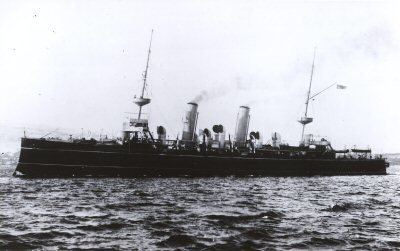Laid down 30 January 1895 Construction started 30 January 1895 Length 107 m | Namesake Isis Completed 10 May 1898 Launched 27 June 1896 Draft 6.25 m | |
 | ||
Fate Sold for scrap, 26 February 1920 Builder Fairfield Shipbuilding and Engineering Company | ||
HMS Isis was an Eclipse-class protected cruiser built for the Royal Navy in the mid-1890s.
Contents
Technical details
Eclipse-class second-class protected cruisers were preceded by the shorter Astraea-class cruisers. Isis had a displacement of 5,600 long tons (5,700 t; 6,300 short tons) when at normal load. It had a total length of 373 ft (114 m), a beam of 53 ft 6 in (16.31 m), a metacentric height of around 3 m (9 ft 10 in), and a draught of 20 ft 6 in (6.25 m). It was powered by two inverted triple-expansion steam engines which used steam from eight cylindrical boilers. Using normal draught, the boilers were intended to provide the engines with enough steam to generate 8,000 indicated horsepower (6,000 kW) and to reach a speed of 18.5 knots (34.3 km/h; 21.3 mph); using forced draft, the equivalent figures were 9,600 indicated horsepower (7,200 kW) and a speed of 19.5 knots (36.1 km/h; 22.4 mph). Eclipse-class cruisers carried a maximum of 1,075 long tons (1,092 t) of coal and achieved maximum speed of 20 knots (37 km/h; 23 mph) in sea trials.
It carried five 40-calibre 6-inch (152 mm) quick-firing (QF) guns in single mounts protected by gun shields. One gun was mounted on the forecastle, two on the quarterdeck and one pair was abreast the bridge. They fired 100-pound (45 kg) shells at a muzzle velocity of 2,205 ft/s (672 m/s). The secondary armament consisted of six 40-calibre 4.7-inch (120 mm) guns; three on each broadside. Their 45-pound (20.4 kg) shells were fired at a muzzle velocity of 2,125 ft/s (648 m/s). It was fitted with three 18-inch torpedo tubes, one submerged tube on each broadside and one above water in the stern. Its ammunition supply consisted of 200 six-inch rounds per gun, 250 shells for each 4.7-inch gun, 300 rounds per gun for the 12-pounders and 500 for each three-pounder. Isis had ten torpedoes, presumably four for each broadside tube and two for the stern tube.
Service history
Isis served on the Mediterranean Fleet under Captain George Morris Henderson in early 1900, and on the China Station under Captain Charles Windham from later that year. In late October 1901 she left Hong Kong homebound, arriving at Spithead 17 December. She paid off at Chatham on 18 January 1902 and was placed in the Fleet Reserve as emergency ship. In May 1902, she was posted as tender to HMS Britannia, cadet training ship at Dartmouth. On 22 April 1914, she collided with the British cargo ship Carbineer in the English Channel, sinking Carbineer 1.5 nautical miles (2.8 km) south-southeast of the Owers Lightship; Isis rescued Carbineer′s crew.
In August 1914 with the outbreak of war Isis was brought out of the reserve and deployed to the 11th Cruiser Squadron based on Queenstown(Cobh) Ireland. Latter transferred to the North American & West Indies Station. She was scrapped in 1920
